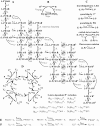Evidence for intermediate S-states as initial phase in the process of oxygen-evolving complex oxidation
- PMID: 18178650
- PMCID: PMC2267143
- DOI: 10.1529/biophysj.107.122861
Evidence for intermediate S-states as initial phase in the process of oxygen-evolving complex oxidation
Abstract
We have analyzed flash-induced period-four damped oscillation of oxygen evolution and chlorophyll fluorescence with the aid of a kinetic model of photosystem II. We have shown that, for simulation of the period-four oscillatory behavior of oxygen evolution, it is essential to consider the so-called intermediate S-state as an initial phase of each of the S(n)-S(n+1), (n = 0, 1, 2, 3) transitions. The intermediate S-states are defined as [S(n)Y(Z)(ox)]-states (n = 0, 1, 2, 3) and are formed with rate constant k(iSn) approximately 1.5 x 10(6) s(-1), which was determined from comparison of theoretical predictions with experimental data. The assumed intermediate S-states shift the equilibrium in reaction P680(+)Y(Z)<-->P680Y(Z)(ox) more to the right and we suggest that kinetics of the intermediate S-states reflects a relaxation process associated with changes of the redox equilibrium in the above reaction. The oxygen oscillation is simulated without the miss and double-hit parameters, if the intermediate S-states, which are not the source of the misses or the double-hits, are included in the simulation. Furthermore, we have shown that the intermediate S-states, together with S(2)Q(A)(-) charge recombination, are prerequisites for the simulation of the period-four oscillatory behavior of the chlorophyll fluorescence.
Figures








Comment in
-
Kinetic models of photosystem II should incorporate a role for QB-nonreducing reaction centers.Biophys J. 2008 Oct;95(7):3113-4; author reply 3115-6. doi: 10.1529/biophysj.108.135426. Epub 2008 Jul 3. Biophys J. 2008. PMID: 18599639 Free PMC article. No abstract available.
References
-
- Wydrzynski, T., and K. Satoh. 2005. Photosystem II: The Water/Plastoquinone Oxido-Reductase in Photosynthesis. Kluwer Academic Publishers, Dordrecht, The Netherlands.
-
- Joliot, P., G. Barbieri, and R. Chabaud. 1969. A new model of photochemical centers in system 2. Photochem. Photobiol. 10:309–329.
-
- Joliot, P. 2003. Period-four oscillations of the flash-induced oxygen formation in photosynthesis. Photosynth. Res. 76:65–72. - PubMed
-
- Shinkarev, V. P. 2005. Flash-induced oxygen evolution and other oscillation processes in photosystem II. In Photosystem II: The Water/Plastoquinone Oxido-Reductase in Photosynthesis. T. Wydrzynski and K. Satoh, editors. Kluwer Academic Publishers, Dordrecht, The Netherlands.
-
- Kok, B., B. Forbush, and M. McGloin. 1970. Cooperation of charges in photosynthetic O2 evolution. I. A linear four-step mechanism. Photochem. Photobiol. 11:457–475. - PubMed
Publication types
MeSH terms
Substances
LinkOut - more resources
Full Text Sources
Miscellaneous

